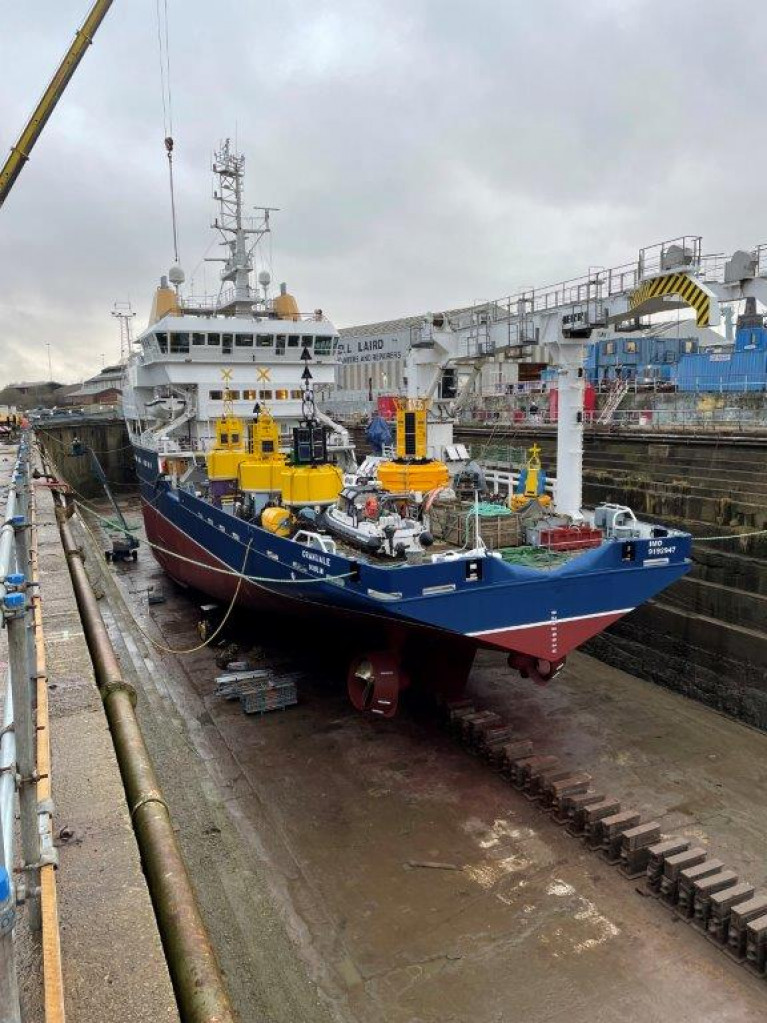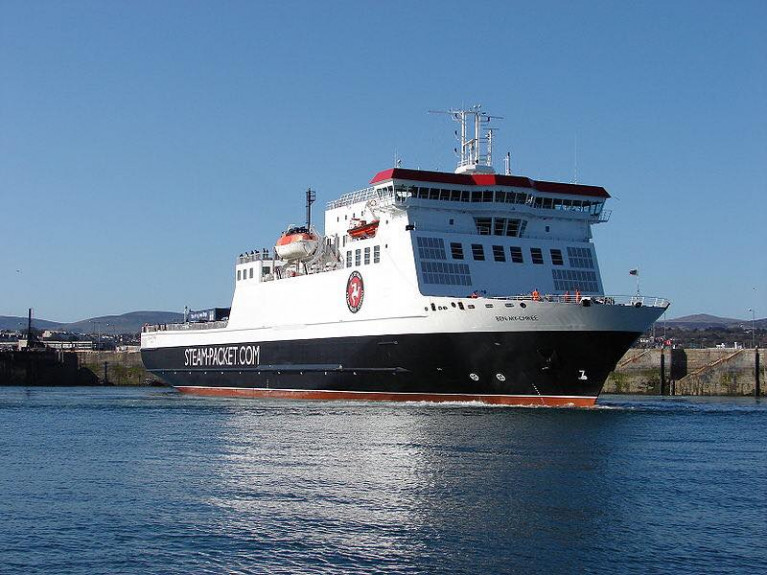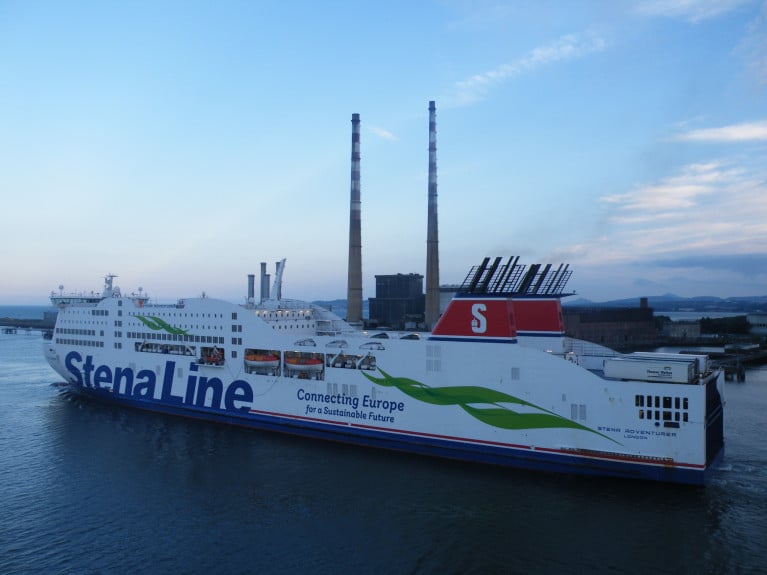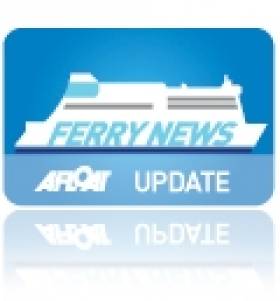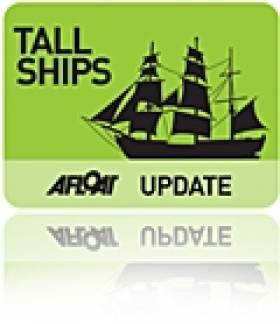Displaying items by tag: DryDocking
The 294m Queen Victoria cruise ship is in Belfast Harbour for dry-docking and is another luxurious vessel turning heads this week.
Putting the sheer scale into context, Queen Victoria as Belfast Telegraph writes, is around 25m longer than the Titanic or the equivalent of 20 buses back to back.
Operated by the Cunard Line, the cruise ship arrived from Tyneside on Tuesday and is capable of carrying more than 2,000 passengers and 980 crew.
Guests can enjoy a spectacular range of entertainment from a full theatre and ballroom to a spa and gym, pool, expanded sun deck and even a winter garden and 6,000 book library.
This time around no tourists are on board as the Queen Victoria is undergoing dry dock operations at Harland & Wolff as Afloat previously reported.
It is now the largest ever cruise ship to have ever dry-docked in a UK shipyard and the only ever Cunard ship to dry-dock in Belfast.
The 270m Aurora from P&O Cruises’ will also arrive in Belfast for dry dock operations.
As previously reported on Afloat, Cammell Laird, the Merseyside shipbuilder and engineering facility has been kept busy with dry-docking a range of ships among them the Commissioners of Irish Lights vessel ILV Granuaile, writes Jehan Ashmore.
The aids to navigation vessel built in 2000, mainly serves in the deployment and recovery of buoys, both inshore & offshore and is used for search and rescue missions, underwent dry-docking at the Birkenhead based facility.
Commenting to Afloat on the dry-docking, Irish Lights said, following a competitive tender process to ensure value for money, ILV Granuaile completed an Intermediate drydock in Cammell Laird during January.
As per SOLAS and Flag State requirements, all merchant vessels require a complete survey of the hull (Special drydock) every five years and an Intermediate survey mid-way in the intervening period. These dry-dockings, include maintenance of the hull, thrusters, anodes, cooling inlets and other parts which are immersed in water and normally inaccessible.
All planned work was delivered and the ship has now returned to regular duties of maintaining lighthouses, buoys and beacons around the coast of Ireland.
Afloat adds ILV Granuaile is currently working in waters off northern Donegal having departed Dun Laoghaire Harbour in recent days.
Main Isle of Man Ferry Returns to Service
The main Isle of Man ferry (has returned) to service after delays during its annual overhaul (at a Merseyside shipyard).
As BBC News reported, the Ben-my-Chree had been due to resume crossings in mid-May but was delayed after inspections found its stern tube bearings were more worn than expected.
The vessel's first passenger and freight journey will leave Douglas for Heysham, Lancashire, at 20:45 BST, the Isle of Man Steam Packet Company said.
The ferry arrived back in Douglas Harbour on Thursday evening.
A Steam Packet spokesman said both the Manannan and MV Arrow, which had been undertaking the services, would "now be rested for a few weeks".
The fastcraft would resume its services to Liverpool on 1 July "subject to borders opening", he added.
Ferries Old & New Swap Stena Sailing Rosters for Annual Dry-Docking
The longest serving Dublin-Holyhead ferry operated by Stena Line departed the Irish capital this morning bound for Falmouth in the UK to undergo annual dry-docking, writes Jehan Ashmore.
Stena Adventurer built in South Korea was launched onto the Irish Sea central corridor route in 2003, is to dry-dock at A&P Falmouth, Cornwall and where a refit of some passenger facilities is also to take place. This is to update passenger facilities among them a 'Hygge' Lounge, a feature on board the new Stena Estrid, the operator's first E-Flexer ropax class built in China which last month entered service.
Taking over the sailing roster of Stena Adventurer is the Stena Estrid. As for newbuild's own roster this in turn is to be covered by Stena Superfast X, which transpires has made a return to its former Irish Sea route to maintain a two-ship service. This follows a stint on the Rosslare-Cherbourg route as Afloat previously reported.
Prior to the Superfast X return to the Ireland-Wales route, a repositioning passage saw the German built ferry depart the Wexford port and arrive at Anglesey yesterday. On Monday, the Ireland-France route's routine ropax ferry Stena Horizon returned from A&P Falmouth having completed a planned dry-docking.
Afloat yesterday evening tracked Stena Adventurer enter Dublin Port following a non commercial sailing from Holyhead, as the ferry did not berth at the ferryport Terminal 2 but instead headed upriver to Ocean Pier, Alexandra Basin East.
According to an Afloat source, Stena Adventurer berthed in the Basin for a Marine Survey Office (MSO) audit. At the same time this allowed relief ferry Stena Superfast X to berth at the nearby ferryport's No. 51 berth, before the 'Adventurer' departed for dry-docking.
The Stena Adventurer remained in Alexandra Basin overnight before departing this morning. The 210m long ferry is expected to arrive at Falmouth tomorrow morning and enter A&P Falmouth's Dry-Dock No.2.
Carlingford Ferry Makes En-Route Call to Arklow Port Prior to Dry-Docking
#FerryNews - Aisling Gabrielle, the ro-ro vessel that launched the first ever Carlingford Lough ferry service last year departed Arklow Port this morning for dry-docking purposes, writes Jehan Ashmore.
The 44-vehicle Aisling Gabrielle opened the new cross-border service linking Greenore Co. Louth and Greencastle, Co. Down last summer, saving considerably mileage and journey times. A relief ferry, Frazer Mariner since the weekend maintains the 20 minute crossings. The service also generated new tourism potential and economic benefits for communities on both shores of the lough.
As for Aisling Gabrielle, a departure took place from nearby Carlingford Pier yesterday and which led to an arrival in Arklow Port mid-afternoon. The en-route call was to load bunkers and a crew rest overnight, with the ferry moored alongside the North Quay.
The same process took place in Wicklow Port last year where Afloat reported of the repositioning voyage of the former Foyle Venture. The ferry had emerged fresh from drydocking in New Ross complete with name change and corporate livery in advance of the new service.
While Aisling Gabrielle is off service for scheduled annual drydocking maintenance, this again sees the return of the UK built ferry to the Wexford Boatyard on the banks of the River Barrow.
As the name suggests, Frazer Mariner is this also operated by the Frazer Ferries Group. The Limerick based company opened the new Scenic Carlingford Ferry service as well as to the re-opening last year of the Lough Foyle service.
Likewise the north-western service is branded similarly as Scenic Lough Ferry, though the Greencastle, Co. Donegal-Magilligan, Co. Derry service is seasonal-only, April to September.
Last year, Aisling Gabrielle also carried out relief crossings for the Group's Waterford estuary service which link's Passage East, Co. Waterford and Ballyhack, Co. Wexford.
The route operated by the 28-vehicle F.B.D. Dunbrody along with the Passage East Ferry Co where acquired by the Group in 2016. The operation continues to trade under the previous name.
It remains to be seen if Aisling Gabrielle during its south-east call will also lead the ferry to relieve on the Passage East service as was the case last year.
New Flagship For CMV Columbus Taking Shape in Rotterdam
#NewFlagship - Columbus, the latest addition to the fleet of Cruise & Maritime Voyages that will also become their new flagship, arrived in Rotterdam just before mid-May for a three week dry dock at the Damen Ship Yard.
A delivery voyage of the Columbus is to take place next month when the 63,000 gross tonnage cruiseship sails to London. At the London Cruise Terminal in Tilbury a naming ceremony is to take place by TV presenter Angela Rippon and a Launch Party on Thursday 8th June. The double event will mark the beginning of Columbus maiden summer season of ex-UK no fly cruises.
As Afloat previously reported, the current flagship Magellan is to call to Dublin early next month. This will be followed by her successor when the 775 passenger Columbus is to make her debut Irish call to the capital but later that same month.
Chris Coates, CMV’s Commercial Director, who visited the ship this week in Rotterdam said, “After over a year of meticulous planning this impressive traditional cruise liner is coming back home to British waters where she was once adored by many passengers and proved a firm favourite with the UK cruise market. The extensive upgrade words are taking shape nicely and we are confident that our passengers will like what they see and the upgrades that we have implemented and Columbus will prove to be a great addition to our fleet”
A lot of the refurbishment and modification works have already taken place during her ballast voyage from Singapore. These ongoing works include re-livery and painting of the ship’s hull and superstructure and the adaptation of the existing child and teenage areas. These areas will be converted to suit CMV’s more mature market. They include a maritime themed Columbus Observation Lounge affording splendid aft ocean views, Trumps & Aces, a spacious Card and Bridge room, a Ship’s Library with a traditional country house style feel and a Crafter’s studio too. The casino has been scaled down and renamed Captain’s Club & Casino while the previously named Captain’s Lounge has been renamed Taverner’s Pub offering a selection of 4 popular draught beers and ales plus 15 other beers and a wide selection of wines and spirits.
After the initial days of welcome onboard events in Tilbury, Columbus will embark on a short three nights cruise 11 June, to Amsterdam and Antwerp, followed by a six nights voyage 14 June to the Norwegian Fjords.
Columbus joins the CMV fleet that includes Magellan, Marco Polo, Astor and Astoria taking CMV’s lower bed ocean fleet capacity to almost 5,000 berths.
#FerryDryDocking – Stena Europe (1981/24,828grt), the Rosslare-Fishguard ferry is this morning bound for Belfast, where she is to be given an annual overhaul in a dry-dock at Harland & Wolff, writes Jehan Ashmore.
The operator, Stena Line have taken the 'Europe' off-service on the southern Ireland-Wales route until the dry-docking is scheduled to be completed on 18 February.
An alternative replacement service with Irish Ferries is available on the Rosslare-Pembroke Dock. Passengers with bookings for Stena Line are advised to contact the operator on 053 91 61567 if they haven't already done so, for further details visit HERE.
According to the Stena website, the first sailing after the replacement service will be the 02.30 Fishguard – Rosslare on 18 February.
As previously reported on Afloat.ie, Irish Ferries transferred yesterday the Isle of Inishmore to the Rosslare-Pembroke, her routine route and follows almost two months service on the Dublin-Holyhead route.
During Isle of Inishmore's second month on the Dublin route in January, she was off-service to undergo overhaul at Cammell Laird, Birkenhead.
Her return brings her fresh into service, as she has already completed an overnight round trip on the Pembroke route.
Volunteers Sought for Tallship that’s Going Bottom's Up!
#TALLSHIPS – What are the chances of getting to see the underside of a ship's hull, let alone the rare opportunity to carry out work on a tallship, look no further than the STV Tenacious, writes Jehan Ashmore.
This unique opportunity to see the hull exposed is to take place this month when the Jubilee Sailing Trust's 65m barque is to undergo anti-fouling work during an 18 day dry-docking. She has only been out of the water twice in the last five years.
Currently the vessel is berthed in Dun Laoghaire Harbour, though is to depart this morning bound for Milford Haven, her final port of call of a seven-day voyage, however she will remain in the Pembrokeshire port where there is a dry-docking facility.
If you can spare the time, volunteers would be most welcomed by the JST to help transform Tenacious, where a successful fundraising effort has raised funds to complete phase 1 of a routine refurbishment needed for the vessel.
Volunteers will be required to carry out the following jobs such as painting the hull, taking off and putting back the rudder, checking the anchors and chains, removing life-rafts for service, taking down yards and overhauling them.
Also involved will be the changing of the "cell" in the sewage plant and work on the master magnetic compass – otherwise known as replacing the "jewel".
So if you want to get up close and personal with a tallship –contact the JST on 00 44 (0)23 8044 9108 Email: [email protected] and by clicking HERE.




























